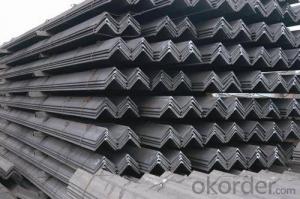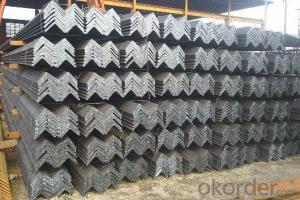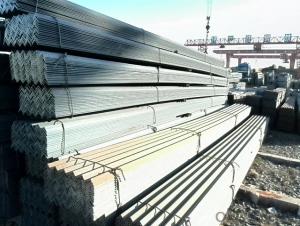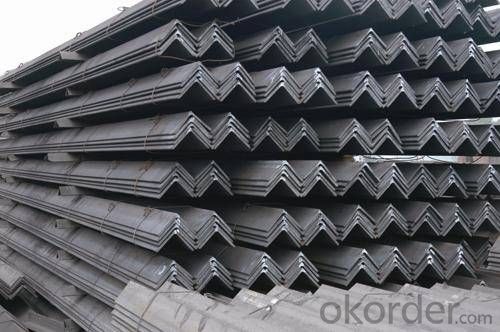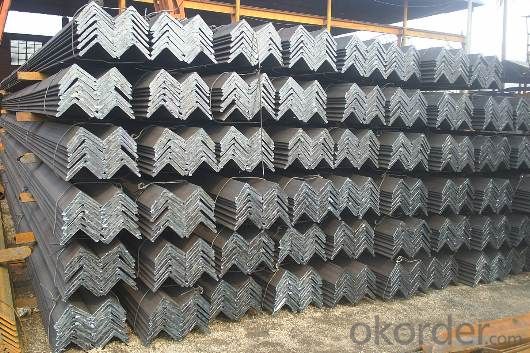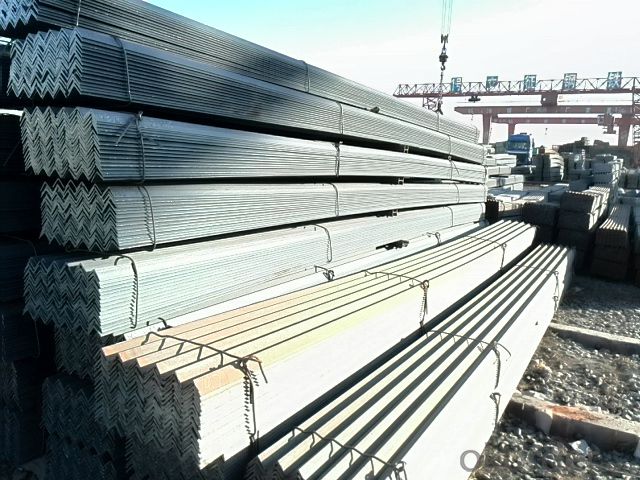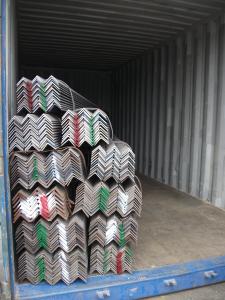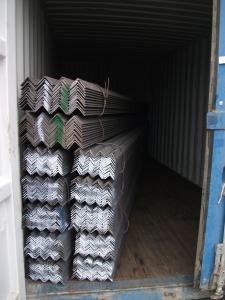Equal steel angle bar
- Loading Port:
- China Main Port
- Payment Terms:
- TT OR LC
- Min Order Qty:
- -
- Supply Capability:
- -
OKorder Service Pledge
OKorder Financial Service
You Might Also Like
Product Description:
Specifications of Angle Steel
1. Invoicing on theoretical weight or actual weight as customer request
2. Length: 6m, 9m, 12m as following table
3. Sizes
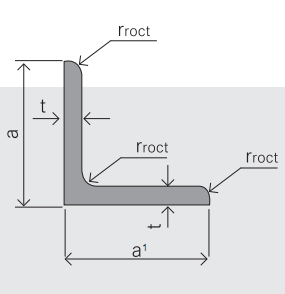
Sizes: 25mm-250mm | ||
a*t | ||
25*2.5-4.0 | 70*6.0-9.0 | 130*9.0-15 |
30*2.5-6.6 | 75*6.0-9.0 | 140*10-14 |
36*3.0-5.0 | 80*5.0-10 | 150*10-20 |
38*2.3-6.0 | 90*7.0-10 | 160*10-16 |
40*3.0-5.0 | 100*6.0-12 | 175*12-15 |
45*4.0-6.0 | 110*8.0-10 | 180*12-18 |
50*4.0-6.0 | 120*6.0-15 | 200*14-25 |
60*4.0-8.0 | 125*8.0-14 | 250*25 |
5. Payment terms:
1).100% irrevocable L/C at sight.
2).30% T/T prepaid and the balance against the copy of B/L.
3).30% T/T prepaid and the balance against L/C
6.Material details:
Alloy No | Grade | Element (%) | | ||||
C | Mn | S | P | Si | | ||
| | |||||||
|
|
|
|
|
|
| |
Q235 | B | 0.12—0.20 | 0.3—0.7 | ≤0.045 | ≤0.045 | ≤0.3 | |
|
|
|
|
|
|
| |
Alloy No | Grade | Yielding strength point( Mpa) | | ||||
Thickness (mm) | | ||||||
≤16 | >16--40 | >40--60 | >60--100 | | |||
≥ | | ||||||
|
|
|
|
|
| | |
Q235 | B | 235 | 225 | 215 | 205 | | |
Alloy No | Grade | Tensile strength (Mpa) | Elongation after fracture (%) | | |||
Thickness (mm) | | ||||||
| ≤16 | >16--40 | >40--60 | >60--100 | | ||
≥ | | ||||||
|
|
|
|
|
|
| |
Q235 | B | 375--500 | 26 | 25 | 24 | 23 | |
Usage & Applications of Angle Steel
According to the needs of different structures, Angle can compose to different force support component, and also can be the connections between components. It is widely used in various building structures and engineering structures such as roof beams, bridges, transmission towers, hoisting machinery and transport machinery, ships, industrial furnaces, reaction tower, container frame and warehouse etc.
Packaging & Delivery of Angle Steel
1. Packing: it is nude packed in bundles by steel wire rod
2. Bundle weight: not more than 3.5MT for bulk vessel; less than 3 MT for container load
3. Marks:
Color marking: There will be color marking on both end of the bundle for the cargo delivered by bulk vessel. That makes it easily to distinguish at the destination port.
Tag mark: there will be tag mark tied up on the bundles. The information usually including supplier logo and name, product name, made in China, shipping marks and other information request by the customer.
If loading by container the marking is not needed, but we will prepare it as customer request.
Production flow of Angle Steel
Material prepare (billet) —heat up—rough rolling—precision rolling—cooling—packing—storage and transportation
- Q: What is the maximum load capacity of a steel angle?
- The maximum load capacity of a steel angle is determined by various factors including its dimensions, thickness, grade, and quality. Steel angles are generally built to withstand significant loads due to their structural characteristics. However, it is essential to refer to engineering specifications and relevant building codes to determine the specific maximum load capacity of a steel angle in a particular application. The load capacity is usually calculated by considering the angle's cross-sectional area, the material's yield strength, and the applied load factors. Furthermore, factors such as the angle's length, support conditions, and the presence of any additional reinforcement or bracing can also affect the maximum load capacity. It is vital to ensure that the steel angle is chosen, designed, and installed correctly to safely support the intended loads and comply with the necessary structural standards.
- Q: Can steel angles be used for door frames?
- Yes, steel angles can be used for door frames. Steel angles are commonly used in construction for their strength and durability. They provide a solid and stable support for the door frame, ensuring its stability and longevity. Additionally, steel angles can be easily customized and cut to fit the required dimensions of the door frame. They are also resistant to warping, rotting, and termite damage, making them an ideal choice for door frames. Overall, steel angles offer a reliable and practical solution for door frame construction.
- Q: Can steel angles be used as supports for signage or lighting fixtures?
- Yes, steel angles can be used as supports for signage or lighting fixtures. Steel angles are commonly used in construction and can provide strong and sturdy support for various applications, including signage and lighting fixtures.
- Q: What are the common applications of steel angles?
- Steel angles are widely used in various applications due to their versatility and strength. Some common applications of steel angles include: 1. Structural support: Steel angles are commonly used as structural elements in buildings and bridges. They provide strength and stability to the structure and are often used as beams, columns, and braces. 2. Construction: Steel angles are used in construction projects to create frames, supports, and reinforcements. They can be used to create corners in walls, support roof trusses, and provide additional strength to concrete structures. 3. Machinery and equipment: Steel angles are utilized in the manufacturing of machinery and equipment. They are often used as brackets, frames, and supports for various components. Steel angles provide stability and structural integrity to these machines. 4. Industrial shelving and racks: Steel angles are commonly used to construct industrial shelving units and racks. They provide a sturdy and reliable structure to store heavy items and maximize storage space. 5. Agricultural equipment: Steel angles are used in the fabrication of agricultural machinery and equipment. They are often used to create frames, supports, and brackets for farm implements such as plows, cultivators, and harvesters. 6. Fencing and barriers: Steel angles are utilized in the construction of fences, barriers, and handrails. They provide a strong and durable structure that can withstand harsh weather conditions and provide security. 7. Transportation: Steel angles are used in the construction of vehicles and transportation equipment. They can be found in truck beds, trailers, and railings. Steel angles offer strength and stability to these structures, ensuring safe transportation of goods and passengers. 8. Decorative and architectural applications: Steel angles are often used in decorative and architectural applications. They can be incorporated into building facades, staircases, and ornamental metalwork. Steel angles provide a modern and sleek look while also offering structural support. Overall, steel angles have a wide range of applications in various industries due to their strength, versatility, and durability.
- Q: What are the different methods for painting steel angles?
- There are several different methods for painting steel angles, depending on the desired result and the specific conditions of the project. Some common methods include: 1. Brush application: This is the most traditional and commonly used method for painting steel angles. It involves using a paintbrush to apply the paint directly onto the surface of the steel angle. This method allows for more control and precision in painting, especially for smaller or intricate areas. 2. Spray application: Spray painting is a popular method for large-scale or industrial projects. It involves using a paint sprayer to evenly distribute the paint onto the steel angle. This method is faster and more efficient than brush application, and it can provide a smooth, uniform finish. 3. Powder coating: Powder coating is a method that involves applying a dry powder to the steel angle, which is then cured under heat to create a durable and attractive finish. This method is known for its resistance to chipping, scratching, and fading, making it ideal for outdoor applications or areas with high traffic. 4. Electrostatic painting: Electrostatic painting is a technique that uses an electric charge to attract the paint particles to the steel angle. This method ensures even coverage and reduced overspray, resulting in a smooth and durable finish. Electrostatic painting is often used for large or complex surfaces, as it can provide superior adhesion and coverage. 5. Galvanizing: Galvanizing is a unique method for protecting steel angles from corrosion. It involves coating the steel angle with a layer of zinc through a hot-dip or electroplating process. Galvanized steel angles are highly durable and resistant to rust, making them suitable for outdoor or high-moisture environments. While galvanizing does not provide a specific color or aesthetic finish, the zinc coating can be painted over if desired. When selecting a painting method for steel angles, it is essential to consider factors such as the desired appearance, durability, environmental conditions, and project specifications. Consulting with a professional or following the manufacturer's recommendations can help ensure the best method is chosen for each unique project.
- Q: What are the different welding methods used for steel angles?
- Steel angles can be welded using various methods, depending on factors such as steel thickness, joint type, and desired outcome. Below are some commonly used welding methods for steel angles: 1. Stick welding, also known as Shielded Metal Arc Welding (SMAW), involves manually feeding a consumable electrode coated in flux into the joint. The flux creates a protective shield around the weld pool. SMAW is versatile and suitable for different joint configurations and thicknesses. 2. Gas Metal Arc Welding (GMAW), commonly referred to as MIG or MAG welding, uses a continuously fed wire electrode through a welding gun. The electrode melts and joins the steel angles together, while a shielding gas protects the weld pool. GMAW is fast and suitable for thin to medium thickness steel angles. 3. Flux-Cored Arc Welding (FCAW) is similar to GMAW, but the wire electrode is filled with flux, eliminating the need for external shielding gas. FCAW is versatile, easy to use, and can be used in various positions. It is commonly used for thicker steel angles and in outdoor applications where wind may affect gas shielding. 4. Gas Tungsten Arc Welding (GTAW), also known as TIG welding, uses a non-consumable tungsten electrode to create an arc. A separate filler metal is manually added to the joint, while a shielding gas protects the weld pool. GTAW produces high-quality, precise welds and is commonly used for thinner steel angles or when aesthetics are important. 5. Submerged Arc Welding (SAW) involves continuously feeding a wire electrode into the joint while covering the weld area with granular flux. The flux acts as a protective medium and prevents atmospheric contamination. SAW is commonly used for thicker steel angles and in applications where high deposition rates are required. These are just a few of the commonly used welding methods for steel angles. Each method has its advantages and limitations, and the choice should be based on project requirements. Consulting with a qualified welding professional is important to determine the most suitable method for a specific application.
- Q: What are the different types of steel angles used in architectural applications?
- There are several types of steel angles commonly used in architectural applications, including equal angles, unequal angles, L-shaped angles, and T-shaped angles. These angles are used to provide structural support, enhance aesthetics, and create unique design features in buildings.
- Q: What are the different types of connections used for steel angles in residential applications?
- In residential applications, steel angles can be connected using various types of connections. Some commonly used ones are: 1. Welded connections: The angle is welded to nearby structural members like beams or columns. Welded connections offer great strength and rigidity, making them ideal for residential purposes. 2. Bolted connections: Bolts and nuts are used to secure the steel angle to adjacent members. This type of connection is suitable when the angle needs to be easily removable or adjustable. Bolted connections are less rigid than welded ones but still provide sufficient strength for residential use. 3. Clip connections: Clips or brackets are attached to the angle, which is then fastened to wood or non-steel materials using screws or nails. Clip connections are commonly used in residential framing. 4. Gusset plate connections: When two steel angles need to be joined, a flat steel plate known as a gusset plate is welded or bolted to the angles for added support and rigidity. This connection type is often found in residential roof trusses and other structural applications. 5. Cleat connections: A steel plate called a cleat is either bolted or welded to the steel angle and the adjacent member. Cleat connections are frequently used when the angle needs to be attached to a horizontal member like a floor or roof joist. These examples showcase the different connection types employed for steel angles in residential applications. The choice of connection will depend on factors such as structural requirements, ease of installation, and the materials being connected.
- Q: What is the difference between galvanized steel angle and ordinary angle iron?
- Ordinary angle iron and hot galvanized steel angle per ton difference of about 2500 yuan.
- Q: What are the safety precautions when working with steel angles?
- When working with steel angles, it is important to follow a few safety precautions. Firstly, always wear appropriate personal protective equipment (PPE) such as safety glasses, gloves, and steel-toed boots to protect yourself from potential injuries. Secondly, ensure that the work area is clear of any obstructions or tripping hazards to prevent accidents. Additionally, make sure to use proper lifting techniques or equipment when handling heavy steel angles to avoid strains or back injuries. Lastly, be cautious of sharp edges and corners on the steel angles and use appropriate tools and techniques to prevent cuts or abrasions.
Send your message to us
Equal steel angle bar
- Loading Port:
- China Main Port
- Payment Terms:
- TT OR LC
- Min Order Qty:
- -
- Supply Capability:
- -
OKorder Service Pledge
OKorder Financial Service
Similar products
Hot products
Hot Searches
Related keywords
